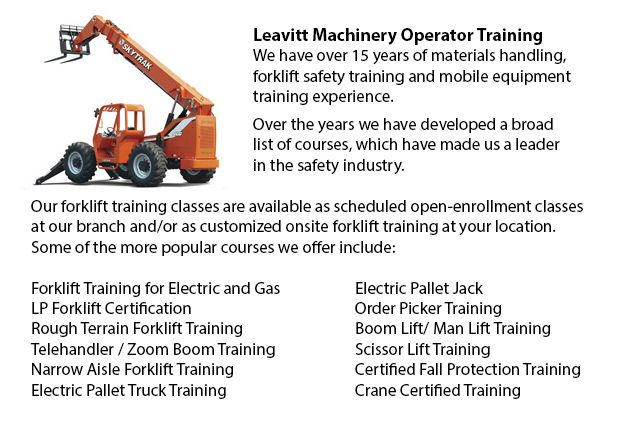
Vernon Telehandler License - The telescopic handler or telehandler is a normally utilized machine in agricultural and industrial applications. This machine is the same in appearance to a forklift and also functions in a similar manner, even if telehandlers are much more like a crane than lift truck. It has a telescopic boom that can extend forward and upward from the motor vehicle. The boom has the capability to fit one of various accessories like for instance a lift table, muck grab, pallet forks or a bucket.
The most popular telehandler accessories are pallet forks. The telehandler is utilized to transport items in areas where the loads cannot be moved by a conventional forklift. Telehandlers are specially helpful for placing loads on rooftops for example, or for removing palletized cargo from with a trailer. Many of the jobs that a telehandler could carry out will otherwise need a crane and this piece of equipment could be costly, not always time efficient and not practical.
The boom acts as a lever, raising and extending while bearing a load. Though there are rear counterweights, this might cause the telehandler to become more unbalanced. Hence, the greatest advantage of the telehandler is likewise its greatest limitation. As the working radius increases, the lifting capacity lessens. The working radius is defined as the distance between the center of the load and the front of the wheels.
For instance, a telehandler with a 5000 lb capability with the boom retracted could safely lift as little as 400 lb as soon as it is completely extended at a low boom angle. The equivalent equipment which has a 5000 lb lift capacity and the boom retracted can support up to 10,000 lb with the boom raised to 70 degrees. The operator has a load chart so as to help determine whether a specific lifting job could be done in a safe and efficient manner. This chart takes into account the weight, height and the boom angle.
Lots of telehandlers come outfitted together with a computer that uses sensors in order to monitor the motor vehicle. These sensors will alert the operator and some are capable of cutting off further control input if the limits of the motor vehicle are exceeded. Several telehandler models are likewise outfitted together with front outriggers which are called mobile cranes. These greatly extend the lifting capability of the machinery while it is stationary.
-
Vernon Heavy Equipment Training Programs
Vernon Heavy Equipment Training Programs - At whatever given construction site, there are often different types of machinery which are ready to be used. These heavy and light machines need both operators to run them and mechanics to fix them. Trainee... More -
Vernon Forklift Safety Training
Vernon Forklift Safety Training - People wanting work in industries that operate lift trucks should undergo a forklift safety training program before becoming a certified operator of a lift truck. There are a lot of ways to go about acquiring forklif... More -
Vernon Aerial Boom Lift Ticket
Vernon Aerial Boom Lift Ticket - Aerial platform lifts can accommodate various odd jobs involving high and tough reaching places. Normally used to complete regular preservation in structures with tall ceilings, prune tree branches, elevate heavy shel... More -
Vernon Manlift Safety Training
Vernon Manlift Safety Training - Manlift operators need to be cognizant and aware of all the potential dangers which are associated with particular classes of scissor lifts. They need to be able to operate the scissor lift in a way that protects not... More -
Vernon Forklift License
Vernon Forklift License - Obtaining a forklift certification or forklift license in North America will require the one training to carry out hands-on training in addition to classroom instruction. The provincial, federal and state regulatory bodies a... More -
Narrow Aisle Forklift, Order Picker, Electric Pallet Jack, Electric Pallet Truck Certification in Vernon
A pallet lift is a model of equipment dedicated in the transporting of pallets of many dimensions and weights. They can be utilized as an appendage for forklifts, cranes and other styles of heavy machinery or be applied on their own. Pallet hoists ar... More -
Vernon Boom Lift Safety Training
Vernon Boom Lift Safey Training - Boom lifts are a type of elevated work platform or aerial lifting device which are commonly utilized in construction, industry, and warehousing. Boom lifts can be utilized in practically any surroundings because of t... More -
Vernon Manlift Operator Training
Vernon Manlift Operator Training - The aerial lift or manlift is a specialized kind of hydraulic platform that is designed to lift a person vertically giving it an alternate name of a vertical personnel lift. These machinery are widely utilized for a... More

Forklift Certification Vernon
TOLL FREE: 1-888-254-6157
Vernon, British Columbia
forkliftcertificationvernon.com
Email Us
About Us


